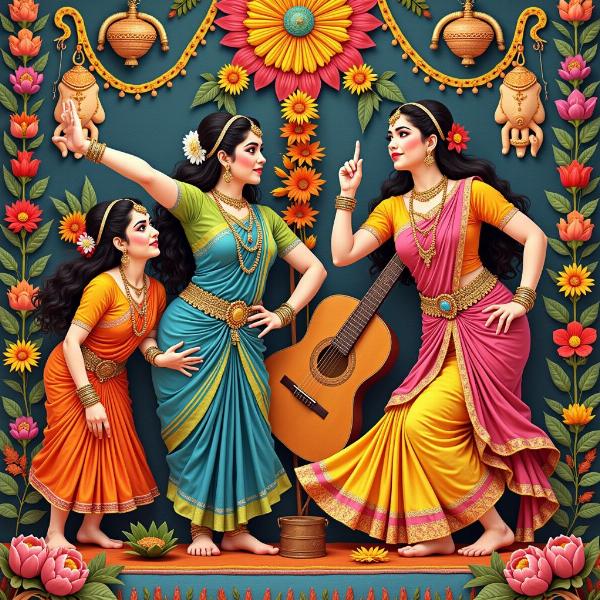Sanskritik, a word deeply embedded in the Hindi language, carries profound meaning related to culture. Understanding its nuances is crucial for anyone seeking to delve into the rich tapestry of Indian traditions and heritage. This article explores the various facets of “sanskritik meaning in hindi,” providing a comprehensive understanding of its significance in different contexts.
Exploring the Depths of “Sanskritik”
“Sanskritik” (सांस्कृतिक) is an adjective derived from the noun “sanskriti” (संस्कृति), which translates to “culture” in English. Therefore, “sanskritik” signifies “cultural” or “relating to culture.” It encompasses a wide range of aspects, including traditions, customs, arts, beliefs, values, and social norms that shape a society’s identity. “Sanskritik” goes beyond mere outward displays and delves into the underlying principles and philosophies that guide a community’s way of life. Whether it’s the vibrant colors of Holi, the rhythmic beats of traditional music, or the intricate carvings of ancient temples, “sanskritik” encapsulates the essence of Indian heritage.
 Sanskritik: Depicting Indian Culture
Sanskritik: Depicting Indian Culture
Sanskritik Activities: Expressions of Heritage
“Sanskritik karyakram” (सांस्कृतिक कार्यक्रम), meaning “cultural program” in Hindi, is a common phrase used to describe events showcasing various art forms. These programs can range from classical dance performances like Bharatnatyam and Kathak to musical concerts featuring traditional instruments like the sitar and tabla. They serve as platforms to preserve and promote India’s rich artistic heritage, passing it down through generations. Attending a “sanskritik karyakram” is not just entertainment; it’s an immersive experience that connects individuals with their cultural roots.
The Role of Sanskritik Values in Society
Sanskritik values form the bedrock of Indian society. Concepts like respect for elders, hospitality, and the importance of family are deeply ingrained in the Indian psyche. These values, often passed down through oral traditions and religious teachings, influence everyday interactions and shape individual behavior. They provide a moral compass, guiding people to live harmonious and fulfilling lives.
Sanskritik Significance in Modern India
While India embraces modernization, the importance of “sanskritik” remains undiminished. In fact, there’s a growing awareness of the need to preserve and promote cultural heritage in the face of globalization. This has led to a resurgence of interest in traditional arts, crafts, and languages. From Bollywood movies incorporating classical dance sequences to fashion designers drawing inspiration from traditional motifs, “sanskritik” continues to permeate various aspects of contemporary Indian life.
What Does Sanskritik Mean in Different Contexts?
“Sanskritik” can take on slightly different meanings based on the context. For example, “sanskritik virasat” (सांस्कृतिक विरासत) refers to “cultural heritage,” encompassing tangible and intangible aspects of culture passed down through generations. “Sanskritik parivartan” (सांस्कृतिक परिवर्तन) denotes “cultural change,” acknowledging the dynamic nature of culture and its evolution over time.
Conclusion: Embracing the Richness of Sanskritik
“Sanskritik meaning in hindi” encapsulates the very essence of Indian culture, encompassing its traditions, values, arts, and beliefs. Understanding its significance allows for a deeper appreciation of India’s rich heritage and its enduring impact on society. As India continues to evolve, “sanskritik” will remain a vital thread connecting its past, present, and future.
FAQ
- What is the opposite of “sanskritik” in Hindi? There isn’t a direct antonym, but “asanskari” (असंस्कारी) can be used to describe someone lacking cultural refinement.
- How is “sanskritik” used in everyday conversation? It’s often used to describe events, activities, or objects related to culture, such as “sanskritik karyakram” (cultural program) or “sanskritik vastuen” (cultural artifacts).
- Why is preserving “sanskritik” important? It helps maintain a sense of identity, fosters unity, and provides valuable insights into a society’s history and values.
- How can I learn more about Indian culture? Exploring museums, attending cultural events, reading literature, and interacting with people from different cultural backgrounds are great ways to learn.
- What is the relationship between “sanskritik” and “sanskar”? “Sanskar” (संस्कार) refers to values and etiquette instilled in individuals, contributing to their overall cultural upbringing. “Sanskritik” encompasses the broader context of culture itself.
- Are there regional variations in the understanding of “sanskritik”? While the core meaning remains consistent, regional variations in cultural practices and traditions can influence the specific interpretation of “sanskritik.”
- How does “sanskritik” influence Indian art and literature? It provides a rich source of inspiration, themes, and motifs, shaping the creative expressions of artists and writers.
Meaning-Hindi.in is your trusted partner for all your Hindi translation needs. We specialize in a wide range of translation services, including business and commercial documents, legal and certified translations, technical manuals, website localization, educational materials, and urgent translations. Our team of expert linguists ensures accurate and culturally sensitive translations that meet your specific requirements. Contact us today for a free quote at [email protected] or call us at +91 11-4502-7584. Meaning-Hindi.in is committed to providing high-quality translation services that bridge language barriers and facilitate effective communication.